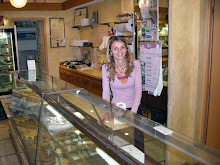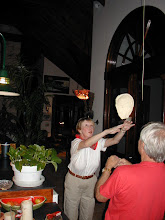Thursday, December 30, 2010
French onion soup – a perfect dish to serve after a night out on the town
French onion soup is a perfect dish to serve after a night on the town. In fact, it gained its popularity in Paris as the “middle of the night restorative” during the days of Les Halles, Paris’ former wholesale food market. In the old days revelers and nighthawks would come to the market at Les Halles for a bowl of soup at dawn after the clubs closed.
According to Dorie Greenspan in her wildly popular new cookbook Around My French Table, the secret to making a great onion soup is patience. To quote Dorie, “cook the onions until they are almost the color of mahogany and everything after that will be perfect.” She goes on to say, “the onions can take up to an hour or more to brown and don’t be tempted to speed things up, because if you burn the onions, your soup will have a bitter taste.” She also advises that if you want your soup to live up to the French standards of Les Halles, you must serve it brûlante, or burning hot.
Speaking of onions, I don’t salt them while they are browning because salt inhibits their ability to brown. Most onion soups call for thinly slicing the onions, but we’ve found that if you chop them, the soup is easier to eat and the onions don’t slide off of your spoon, which Meakin jokingly refers to as a "leaky lip." To make the topping, if your broiler isn’t strong or you don’t have a kitchen torch to melt the cheese, you can make cheese toast in a separate step as I’ve done here.
French onion soup, minus the bread and cheese of course, can be made in advance and kept covered in the refrigerator, making it perfect for a late night meal when you’ve been out on the town. Add a tossed green salad and you’re all set.
French Onion Soup
Adapted from Williams Sonoma Foods of the World – Paris - with advice from Dorie Greenspan
Printable Recipe
2 ½ pounds yellow onions, chopped
3 tablespoons unsalted butter
1 tablespoon canola oil
Pinch of sugar
1 teaspoon minced fresh thyme leaves
Kosher salt and freshly ground black pepper.
2 cups red wine
8 cups low-sodium beef stock
1 dried bay leaf
2 tablespoons cognac or brandy
6 thick slices of a French baguette
3 cups hand grated Gruyere cheese
In a large, heavy pot over medium-low heat, melt the butter with the oil. Add the onions, cover and cook, stirring occasionally, adding the sugar, until the onions are meltingly soft, golden and lightly caramelized, about 45 minutes to an hour, taking care not to let the onions burn. Add the chopped fresh thyme leaves, salt and pepper and cook a minute or two more. It is important not to salt the onions until they have browned. If you salt the onions beforehand, they won’t brown as well.
Add the wine, raise the heat to high, and cook until the liquid is reduced by half, 8 – 10 minutes. Add the stock and bay leaf reduce the heat to medium-low, and let the soup simmer, uncovered, until it is dark and fully flavored, about 45 minutes. If the liquid is evaporating too quickly or the soup taste too strong, add a little water, then cover and let it continue to cook.
Just before serving, remove the bay leaf and discard. Add the cognac or brandy and let the soup sit for a few minutes. In the meantime, toast the bread on both sides, either in a toaster oven or in a preheated 400 degree F oven, then add the shredded gruyere cheese on top of one slice, return to the toaster or oven until the cheese has melted. Serve the soup burning hot. Makes about 4 servings.
Monday, December 27, 2010
A fruit platter and cheese grits soufflé are perfect brunch side dishes
 |
| Pineapple with cranberries & mint |
We spent Christmas morning at Meakin’s brother’s house where we enjoyed a scrumptious brunch after opening packages. As you can see, our little nieces were thrilled with what Santa brought them.
 |
| Our niece loves The Little Mermaid |
 |
| Our niece showing Aunt Tammy her new boots
|
 |
| Popovers |
 |
| Pineapple with cranberries & mint |
Adapted from Ocado
1 large fresh pineapple
About 3 tablespoons (or more if you wish) dried cranberries
1 – 2 tablespoons gold rum
1 lime, zest grated and juice reserved
About 3 tablespoons (or more) fresh mint leaves, chopped
2 tablespoons brown sugar
Using a sharp knife, cut away the skin from the pineapple and discard the skin and top. Cut the flesh into quarters, remove and discard the woody core, and slice into spears. In a small bowl, pour some gold rum over the dried cranberries and set aside to plump.
Arrange the pineapple spears on a serving platter and squeeze the lime juice over, and then scatter the cranberries over the pineapple and drizzle with the rum. In a small bowl, add the chopped mint, lime zest and brown sugar, and mix well. Drizzle the mixture evenly over the fruit, then chill the fruit in the refrigerator for at least 1 hour. Before serving, bring back to room temperature. Serves 6 to 8.
 |
| Cheddar cheese grits souffle |
Cheese Grits Soufflé
Adapted from Southern Living
4 cups milk
3 tablespoons butter
1 1/2 teaspoons kosher salt
1 cup uncooked quick-cooking grits
1 large egg, lightly beaten
½ teaspoon freshly ground black pepper
2 cups (8 ounces) shredded sharp Cheddar cheese
½ cup finely chopped parsley or herbs of your choice
4 tablespoons grated Parmesan cheese
Bring milk just to a boil in a large saucepan over medium-high heat; add salt, then gradually whisk in butter and grits. Reduce heat, and simmer, whisking constantly (whisking keeps grits from spattering on you and the stove), 5 to 7 minutes or until grits are done. Remove from heat and taste for salt. (We usually add more salt.)
Into the hot grits, stir in the lightly beaten egg, freshly ground black pepper, cheese, and chopped parsley. Pour into a lightly greased soufflé dish. (You could also use a 11- x 7-inch baking dish.) Sprinkle the grits with grated Parmesan cheese. Bake, covered, at 350° for 35 to 40 minutes or until mixture is set. Serve immediately. Garnish, if desired. Yield: 6 – 8 servings.
 |
| Cheese grits souffle with red peppers |
Prepare grits as above and add the sautéed red peppers at the same time you add the cheese.
1 sweet red bell pepper, finely chopped
1 tablespoon olive oil
Kosher salt and freshly ground black pepper
In a 10” non-stick skillet, heat the olive oil, and then add the chopped red bell pepper and sauté for about 4 to 5 minutes, until it softens. Season with salt and freshly ground black pepper. Remove from the heat and add to the hot grits when you add the cheese.
Friday, December 24, 2010
Moooooy Christmas !
Moooooy Christmas !
This is our Christmas card this year. It’s from a painting by Tim Knepp titled “Ho, Ho, Holstein.”
I couldn’t resist it. It just looked so “North Carolinian” with the cow in the snow in front of a red barn. Here in the mountains, farms with cows and red barns are still the norm. Everyday farmers can be seen driving their tractors along on our winding roads to bring bales of hay to their cows. Yesterday morning we saw a new baby cow nestled between two big cows eating hay for breakfast. It’s been bitter cold here and that baby is one smart little cow. He’s already figured out how to keep warm.
Some interesting tidbits about Holstein cows:
One of the oldest dairy breeds, the Holstein’s development began almost 200 years ago when people of the Netherlands began selectively breeding the cow for its efficient use of their land’s most abundant resource, grass. The Holstein is long valued in Europe as a high yielding milk cow. American farmers, eager to meet the growing demands for milk products, looked to the Holstein. The first cow arrived in American in 1825. Today the splash black and white Holstein dominates the dairy industry and is valued for its generic superiority.
Ho, Ho, Holstein.
Meakin and I wish you a very merry Christmas filled with wonderful food, family and friends. Happy holidays to you and your family. Be good 'cause Santa Claus comes tonight.
Sam & Meakin
Monday, December 20, 2010
Barefoot Contessa’s roasted lemon chicken & roasted rainbow carrots
Have you bought your copy of The Barefoot Contessa’s latest cookbook How Easy is That? If not, you’d better hurry if you want it under your tree for Christmas. The book is all that the title promises and more. How does popcorn drizzled with truffle butter sound served with a glass of bubbly? Or perhaps you prefer rich fresh salmon tartare or roasted figs with proscuitto. It’s all in the book, plus lots of other easy but sophisticated recipes that only Ina knows how to do best.
One of my all time favorite recipes of Ina’s is roasted chicken breasts. You’ve probably even made it yourself. Drizzle some extra virgin olive oil over chicken breasts with bones, sprinkle with kosher salt and freshly ground black pepper, pop in a preheated 350 degree F oven for 30 – 40 minutes and you have the best and easiest roasted chicken breasts ever. And – with the leftovers, you can have a chicken sandwich or salad the next day. It’s a “go-to” in our house on a regular basis.
In her new cookbook, she’s added fresh lemons and garlic to the chicken breasts and it’s even more fabulous than her original recipe. All she did was heat a little extra virgin olive oil in a sauce pan and add some chopped fresh garlic and let heat ever so gently until the garlic softens but doesn’t start to brown. Off heat, add a splash of dry white wine, a squeeze of fresh lemon juice, some chopped fresh thyme and a pinch or so of dried oregano to the olive oil mixture, pour over the chicken breasts (no bones this time, but still skin), throw in some slices of fresh lemon and cook at 400 degrees F for 30 minutes or so and you’ve got the most fabulous baked chicken ever.
I decided to serve the lemon roasted chicken with roasted carrots. When I found these organic rainbow carrots at the market, I knew they would be a fabulous choice. Since they are organic, I washed them but it’s not necessary to peel them. One was larger than the other, so I sliced it in half. I drizzled them with some extra virgin olive oil and sprinkled them with kosher salt, freshly ground black pepper and chopped fresh thyme leaves and roasted them in the same 400 degree F oven with the chicken for 20 – 30 minutes, depending on their size and voila, dinner was ready.
How easy is that?
Thursday, December 16, 2010
Pfeffernusse cookies & Italian espresso with a special "house seasonings"
 |
| Pfeffernusse cookies |
Pfeffernusse cookies are a traditional Christmas cookie from Germany and elsewhere in Eastern Europe. They are what I refer to as an “old world” cookie and you hardly ever see them anymore. Both Meakin and I are of German heritage, so these cookies are a tradition in both of our families.
Pfeffernusse cookies are covered in confectioner’s sugar and taste similar to gingerbread, but are spicy and seasoned with black pepper. In appearance pfeffernusse cookies can be confused with Mexican wedding cake cookies because both are covered in confectioner’s sugar.
I'm sure our ancestors must have made batches of these cookies, but since I’m not much of a baker, we buy our pfeffernusse cookies. However they aren’t always easy to find. Archway brands makes a very good cookie and I’ve also been able to find them at The Fresh Market. I grab several boxes as soon as I see them in December. I’ve found a couple of recipes on line at Fabulous Foods and All Recipes for those of you who are bakers and would like to add them to your cookie collection. If you have a recipe you would like to share with me, I would love to hear from you.
 |
| German Gluhwein |
Pfeffernusse cookies are wonderful served with espresso or German Gluhwein. Last year I posted a recipe for German Gluhwein, taken from an old German cookbook, if you would like to make your own. It’s super simple and not too sweet.
I would like to share some secrets to making a good cup of espresso and a little “house seasoning blend” that I got from a friend’s Italian grandmother that makes the espresso taste even better. You’re probably thinking who needs a recipe for espresso? Just stay with me for a moment and you’ll see.
First of all, I use the Bialetti Moka Express espresso stovetop pot. It’s the Italian made aluminum one with the funny looking little fellow with the mustache on the pot. Bialetti is the world’s number one coffee-maker and the most copied coffee coffee-maker in the world, so don’t settle for an imitation. Best of all, it’s not expensive. The six cup version costs around $30 and sizes range from one cup to twelve. Not a bad price considering some of the electric espresso machines can run into the hundreds of dollars.
Always buy the best coffee you can find. We prefer the Italian illy brand because it is 100% sustainably grown Arabica coffee and in our own taste tests, it always wins hands down to other brands.
I mix the Illy espresso blend with a little of what I call “my house seasonings.” An excellent Italian cook shared her grandmother’s espresso seasonings with me and I want to pass it on to you. She whispered to me, "This will take the bitterness out of the espresso and no one will know your secret." This is how you do it.
Before brewing, sprinkle the coffee grounds with a little sugar (to your taste – I don’t use very much) and top with one star anise. When I don’t have a star anise, I’ve substituted a good pinch of anise seeds with excellent results. Mix every so slightly, then brew your espresso according to the manufacturer’s direction. That’s all there is to it. Very easy and so, so delicious. Great for a snowy day. Here’s our first big snowfall of the season. Winter’s starting early this year.
These are my own opinions and I was not compensated by any brand name mentioned..
Subscribe to:
Posts (Atom)












































